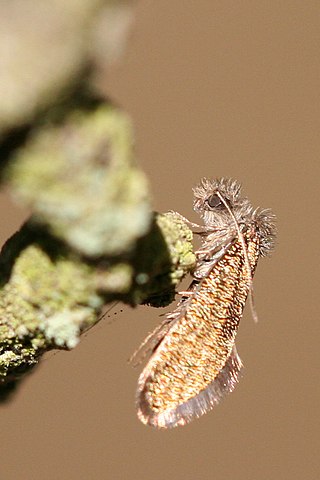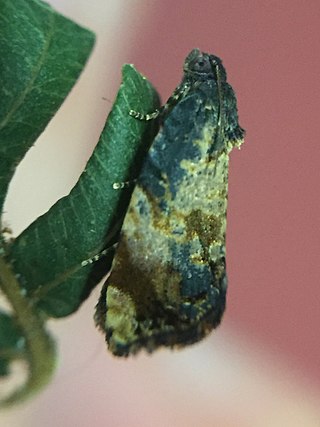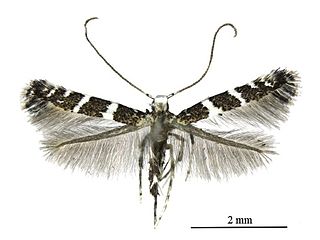
Dyseriocrania subpurpurella is a diurnal moth from the family Eriocraniidae, found in most of Europe. The moth was first named by the English entomologist, Adrian Hardy Haworth in 1828.

Prays fraxinella, also known as the ash bud moth, is a moth of the family Plutellidae found in Europe. The larvae are leaf miners, feeding on the leaves and buds of ash trees.

Eriocrania sangii, the large birch purple, is a moth of the family Eriocraniidae found in Europe and described by John Henry Wood in 1891. The moth can be found flying in sunshine around birch trees and the larvae feed on birch leaves.

Eriocrania sparrmannella also known as the mottled purple is a moth of the family Eriocraniidae, found in Europe and Japan. It was first described by the French entomologist, Louis Augustin Guillaume Bosc in 1791. The specific name honours the Swedish naturalist Anders Erikson Sparrman. The larvae mine the leaves of birch.

Parornix anglicella is a moth of the family Gracillariidae found in Asia and Europe. It was described in 1850, by the English entomologist Henry Tibbats Stainton, from a specimen from Lewisham, Kent.

Philocryptica is a monotypic genus of moths belonging to the subfamily Tortricinae of the family Tortricidae. It contains only one species, Philocryptica polypodii, the leather-leaf star-miner, which is endemic to New Zealand. This species has been recorded in both the North Island and the South Island, as far south as Banks Peninsula. The preferred habitat of this species is native forest where the species' larval host is present. The larvae feed on Pyrrosia eleagnifolia, mining the host plant leaves. P. polypodii pupates within the final blotch-mine. Adults are on the wing in November and December.

Ectoedemia intimella is a moth of the family Nepticulidae which is found in Europe. It flies in June and July and the larva mine the leaves of willows from July to November.

Stigmella cypracma is a species of moth of the family Nepticulidae. It is endemic to New Zealand and has been observed in the North and South Islands. The larvae of this species are leaf miners and pupate within their mines. The larval host species is Brachyglottis repanda. Adult moths are on the wing in February and September to November. This species has two generations per year.

Stigmella fulva is a moth of the family Nepticulidae. It is endemic to New Zealand and has been observed in the North Island around Mount Taranaki, in the South Island and at Stewart Island. The species' eggs are laid singly but a considerable number may be deposited on the upper surface of one leaf. The incubation period can last from a week to a month depending on climatic conditions. The larvae mine the leaves of their host plants which are all in the genus Olearia. Larvae have been recorded in all months except January, February and June. The cocoon is brown and spun amongst the leaf litter under its host plant. The pupal period has been shown to range from 21 days to 79 days, again depending on climatic conditions. Adults have been observed on the wing January until March and August to December. They are active in the sun about their larval food plant.

Hellula undalis, the cabbage webworm or Old World webworm, is a moth of the family Crambidae. It is a widespread species which is found from Europe across Asia to the Pacific. It was first described from Italy.
Ectropina raychaudhurii is a species of moth of the family Gracillariidae. It is known from Tamil Nadu, India.
Cameraria macrocarpae is a moth of the family Gracillariidae. It is only known from Manitoba, Canada.
Prophyllocnistis epidrimys is a moth of the family Gracillariidae. It is known from Chile.
Liocrobyla paraschista is a moth of the family Gracillariidae. It is known from Fiji, India and Japan and Korea.

Conopomorpha flueggella is a moth of the family Gracillariidae. It is known from Tianjin, China.

Phyllocnistis hyperpersea is a moth of the family Gracillariidae. It is found from Nansemond and Virginia Beach Counties in Virginia, south along the lowland Atlantic coastal region to the Florida Everglades. It might have a much wider range, since material which might belong to this species has been recorded from Honduras and Mexico.

Phyllocnistis subpersea is a moth of the family Gracillariidae. It is found in the Dade and Monroe Counties of Florida. Mines of what appear to be this species have been found as far north as the Green Swamp in coastal South Carolina.

Macrosaccus gliricidius is a moth of the family Gracillariidae. It is known from Central America and the West Indies.

Telamoptilia grewiae is a moth of the family Gracillariidae. It is found in China (Tianjin).

Micrurapteryx caraganella is a moth of the family Gracillariidae. It is found in Siberia, and possibly Tajikistan and the Russian Far East.


























